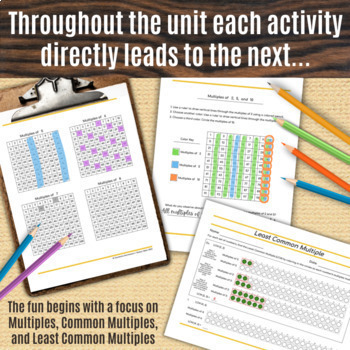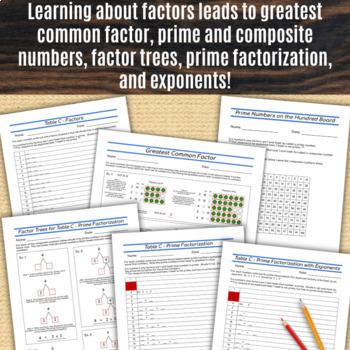Montessori Factors and Multiples Worksheet BUNDLE - Montessori Multiples GCF LCM
- Google Drive™ folder

Products in this Bundle (4)
Bonus
Description
Need fun factors and multiples worksheets to explore multiples numbers, factors chart from 1 to 100, prime and composite numbers, gcf lcm, factor trees, prime factorization, and more? This Montessori Multiples and Factors Bundle has 12 activities that introduce concepts and build on each other to make learning easy! Developed as a Montessori Factors and Multiples materials, these activities are great for any elementary math class!
Click on the ⭐️PREVIEW⭐️ for a visual walk-through of what’s included and how it all works together!
Researching Multiples is great follow up after introducing the idea of multiples. Kids get excited when they begin to see the patterns form!
Kids can use their completed first worksheet to help them complete Researching Common Multiples, or they can use the included Multiples of Numbers 2 to 10 reference sheet. This worksheet has clear instructions to walk kids through exercises to reveal relationships between common multiples. This is the perfect intro to least common multiple or LCM.
Least Common Multiple is now a snap to understand because of the prior exercises!
Table A and Table B each show kids the multiples of numbers 2 to 10 with products to 50 (Table A) or from 51 - 100 (Table B).
Kids can use their completed Tables A and B to help them complete Table C - Facts, in which they compile the multiplication facts by product. For example, for the number 12, the answers would be 1 x 12, 2 x 6, and 3 x 4.
Next comes Table C - Factors, for which students will rely on their completed Table C - Facts. Now the factors for each number are listed. For example, for the number 12, the answers would be 1, 2, 3, 4, 6, and 12.
Greatest Common Factor is next, and is easy to understand now that the foundation of factor understanding has been laid!
Prime Numbers on the Hundred Board will become a reference sheet after kids color in all the prime numbers within 100.
Kids use their completed Prime Numbers on the Hundred Board sheet to help them make factor trees for all composite numbers between 4 and 100. Clearly guided instructions and easy formatting make Factor Trees for Table C - Prime Factorization a breeze to complete!
Next, kids can use their completed factor trees to help them complete Table C - Prime Factorization, in which they record the prime factorization for numbers 1 - 100. For example, for the number 12, the answer would be 2 x 2 x 3.
Next comes Table C - Prime Factorization with Exponents, for which students will rely on their completed Table C - Prime Factorization. Now the prime factorizations are listed more concisely using exponents. For example, for the number 12, the answer would be 2² x 3.
Here’s What You Get
12 Worksheets
- Researching Multiples of Numbers 1 to 12
- Researching Common Multiples
- Least Common Multiple
- Table A
- Table B
- Table C - Facts
- Level 1 version (students are shown how many facts equal each product)
- Level 2 version (students are left to figure out for themselves how many facts equal each product)
- Table C - Factors
- Level 1 version (same format as above)
- Level 2 version (same format as above)
- Greatest Common Factor
- Prime Numbers on the Hundred Board
- Factor Trees for Table C - Prime Factorization
- Table C - Prime Factorization
- Level 1 version (students are shown how many factors comprise each number’s prime factorization)
- Level 2 version (students are left to figure out for themselves how many factors is correct)
- Table C - Prime Factorization with Exponents
- Level 1 version (same format as above)
- Level 2 version (same format as above)
1 Reference Sheet
- Multiples of Numbers 2 to 10
12 Answer Keys to above worksheets
Record Keeping / Sequenced Lesson List
- Printable PDF
- Editable Google Sheets
Ideas for Use
These exercises exploring multiples and factors help solidify these concepts before introducing Least Common Multiple and Greatest Common Factor.
Included activities which explore prime numbers, factor trees, prime factorization, and exponents provide a solid foundation before kids begin to learn algebra concepts such as factoring rational expressions.
Because of the graduated design of the worksheets, kids with an understanding of multiplication and division facts will be successful with them. The vertical format of the worksheets provides more space for writing than the traditional horizontal layout. Limiting each page to only 25 numbers helps prevent overwhelm on the Table Cs.
Teachers Like You Said…
⭐️⭐️⭐️⭐️⭐️ Kelly says, "By far the most beautiful presentation I have found for Tables A, B and C. "
⭐️⭐️⭐️⭐️⭐️ Bethany says, "This was such a helpful resource. I used it in my self-contained classroom and it helped my students grasp the concept of factors and multiples."
For Related Products
Follow Us to Get New Products at 50% Off!
Our new products are 50% off for the first 48 hours, so click to FOLLOW US and receive emails whenever we list a new product!
Please email with any questions you may have! info@robynwellsmontessori.com
Copyright © Gardenia Montessori
All rights reserved by author.
Permission to copy for single classroom use only. Please purchase additional licenses if you intend to share this product.





